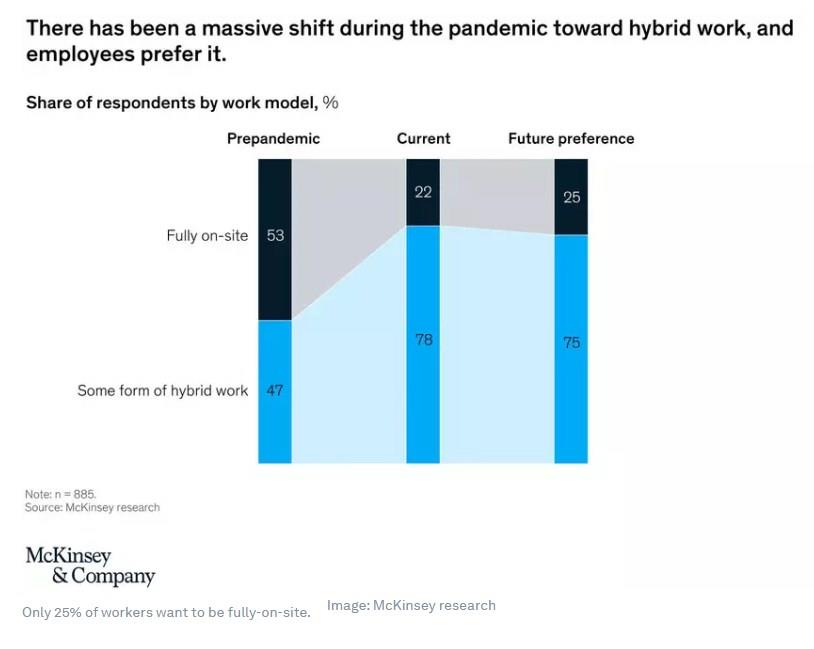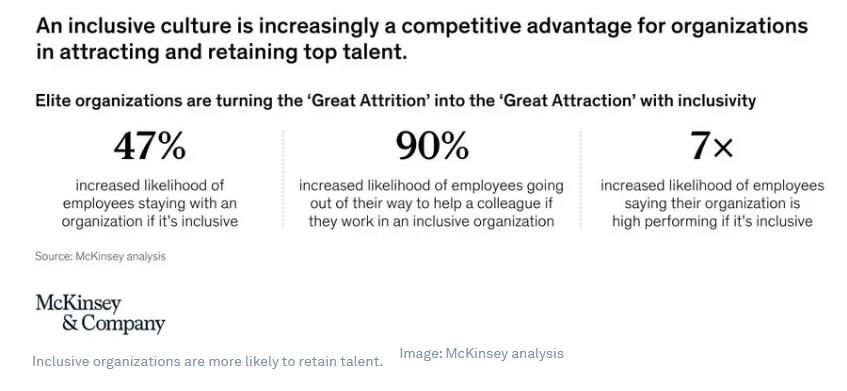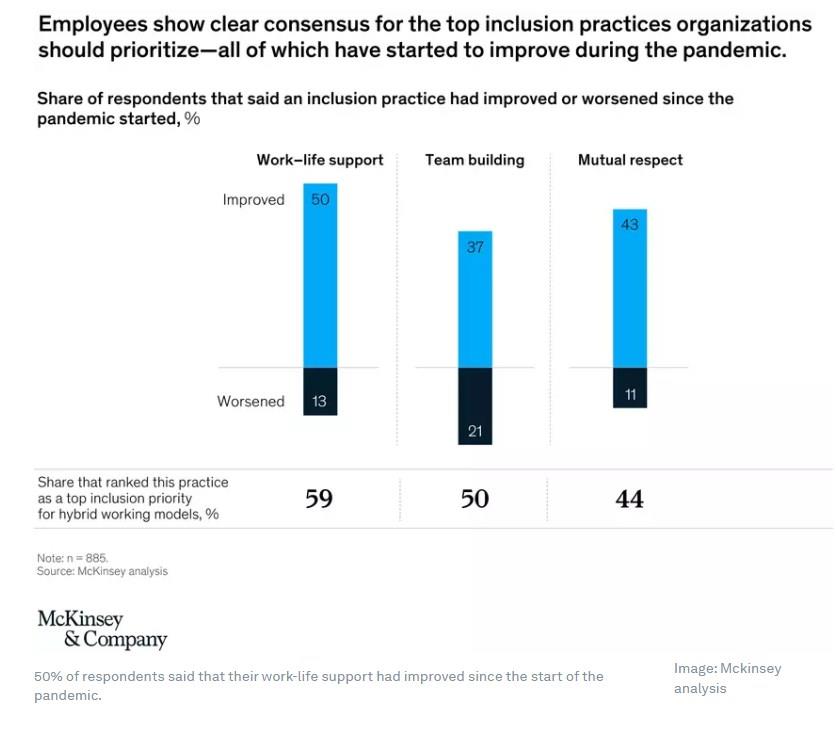by Bonnie Dowling, Drew Goldstein, Michael Park and Holly Price*
After the Great Resignation comes the Great Renegotiation. Over the past two years, millions of people and organizations around the world were forced into hybrid virtual work, many for the first time. Survey after survey has shown that employers eagerly hope their employees will return to the office as soon as possible. Employees? Not so much, for reasons including health, family, and the work–life balance. Now, vaccines and therapies hold out the promise of normalizing life under the coronavirus and its variants, but employees increasingly hold more bargaining chips in a great debate now underway over the future of workplace models.
Our latest research reinforces the idea that hybrid work is here to stay. More than four out of five survey respondents who worked in hybrid models over the past two years prefer retaining them going forward. At a time when organizations are plagued by burnout, mental-health issues, and record numbers of employees leaving their jobs, leaders who see in-person work as a return to normality must confront just how strongly employees feel about flexible workplace models and their growing leverage to pursue them. We found that more than two out of three employees who prefer hybrid models say they are likely to look for other opportunities if asked to return fully on-site. Despite such popular support, the experience of employees with hybrid work during the pandemic has varied widely in key areas, such as a sense of inclusion and the work–life balance. For some traditionally underrepresented identities, this variability is exacerbated.
As employers work to refit existing workplace models, they face a classic risk/reward choice. Hybrid work has the potential to offer a higher level of flexibility, a better work–life balance, and a more tailored employee experience. These can have a disproportionately positive impact on diversity, equity, and inclusion (DEI) efforts, as well as on performance. Hybrid work also has the potential to create an unequal playing field and to amplify in-group versus out-group dynamics, which can flip those advantages to the liabilities side of the ledger. For workplaces already challenged to diversify and retain employees, adopting ill-conceived hybrid work models could instead speed departures, decrease inclusion, and harm performance.
Make no mistake: tapping the benefits of a more inclusive hybrid work culture is difficult, delicate work. There’s scant evidence of companies that have mastered the challenge. What’s more, the practices needed to take it on can feel nebulous and elusive, especially for leaders who have never worked in a truly inclusive culture themselves. In this article, we share research that illuminates the dynamics that underlie efforts to build inclusion in a diverse, hybrid workforce and the three critical inclusion practices—work–life support, team building, and mutual respect—that leaders should treat as priorities.
A hard look at hybrid
Even before the pandemic, workers craved fluidity: in 2019, our research found that work–life flexibility was the number-one issue employees raised. As the economy navigates the reopening of offices in this next phase of the pandemic, executives often conflate “hybrid” with “flexibility,” especially the location of work. Moreover, today’s hybrid working models were not the product of measured strategic planning but, often, of desperate triage efforts spliced together when disaster struck. Some organizations forced into remote work addressed attrition, isolation, and mental-health woes better than others, but these ill effects remain prevalent across the business landscape, particularly for some traditionally underrepresented groups.
This reality obliges leaders to design better models. True flexibility must go beyond location to include the different preferences and needs of an increasingly diverse employee workforce. It demands a sharp focus on the reasons people have been leaving jobs, often without new job offers in hand: work–life balance and flexibility loom large, but employees also yearn for a greater sense of belonging and of feeling appreciated. Finding the sweet spot between hybrid work and strong inclusion can make an organization a highly attractive place to work but requires leaders, at all levels, to listen, to coach, and to think of flexibility not as an end point but as a set of evolving expectations, with regular adjustments, perhaps down to the level of individual employees.
Despite the variability of hybrid work, employees appear hooked on it and unwilling to let it go. In our survey, 75 percent of all respondents said that they prefer a hybrid working model (Exhibit 1). Only 25 percent said they prefer to be fully on-site.

Who likes hybrid work most?
Of employees currently working in a hybrid model, 85 percent want it retained going forward. This strong preference appears across industries, geographies, and demographic boundaries.
Some traditionally underrepresented groups demonstrated an even stronger preference for hybrid work.
-Employees with disabilities were 11 percent more likely to prefer a hybrid work model than employees without disabilities.
-More than 70 percent of men and women expressed strong preferences for hybrid work, but nonbinary employees were 14 percent more likely to prefer it.
-LGBQ+ employees were 13 percent more likely to prefer hybrid work than their heterosexual peers.
Some traditionally underrepresented groups demonstrated an even stronger preference for hybrid work.
For managers sensitive to the importance of inclusion and diversity, such examples highlight another possible dividend from hybrid work models. Consider, for example, the employee who may be hiding a disability, gender identity, or sexual orientation to avoid the stigma that can come with declaring it. Research shows that efforts to conceal such identities may take a toll on an employee’s well-being and performance. Ideally, employees would be comfortable sharing these identities with colleagues, and organizations would provide the inclusive environment in which they could. When they do not, however, hybrid work environments can relieve some of the strain.
Who likes hybrid work enough to quit?
Our research also explored the respondents’ willingness to leave jobs because of work models. For employers battling widespread, rising attrition and an increasing labor shortage as employees quit jobs, even without another offer in hand, such insights could help stanch the talent outflow. Of those who prefer hybrid work, 71 percent say they are likely to look for other opportunities if it is not available where they work now.
These were among the groups that prefer hybrid work and said they were likely to leave if it wasn’t available:
-Younger employees (18–34 years old) were 59 percent more likely to leave than older ones (55–64 years old).
-Black employees were 14 percent more likely than their White peers.
-LGBQ+ employees were 24 percent more likely to leave than heterosexual ones.
-Women were approximately 10 percent more likely than men, and employees who identify as nonbinary were 18 percent more likely than men and women.
-Employees with disabilities were 14 percent more likely to leave than employees without them.
A hybrid workplace of one’s own?
These undercurrents of employee identity, tenure, and experience can make the task of shaping inclusive work environments a daunting one. Some companies are aggressively trying to bring employees back on-site, while others experiment with a range of flexible options. At the extreme, some executives even talk of a need to scale work model personalization, tailoring it to an individual employee’s professional and personal context. To date, the idea of shaping an inclusion approach to an “n of 1” is largely uncharted territory (and so is simultaneously scaling protocols, norms, and ways of working to suit an organization’s shared goals). Managing hybrid teams inclusively to evolving employee expectations will be a proving ground for leaders to demonstrate that they have the leadership skills and methods—such as managing to outcomes and emphasizing social compacts—that can deliver effective solutions.
Amid this flux and experimentation, we believe that widespread employee support for hybrid work suggests that to navigate the present time of transition, leaders should first tap more deeply into their employees’ preferences, needs, and expectations. This requires, at a minimum, setting guidelines and encouraging managers to collect employee feedback regularly as part of experiments with new, agile approaches. Leaders can then incorporate the results into several sound inclusion practices that our research points to as a strong foundation for an inclusive hybrid workplace.
Building the inclusive hybrid workplace
Data are useful to understand the working-model preferences of an organization’s different demographic groups. We also know that the way managers and teams behave day-to-day is the most powerful determinant of the individual employee experience. Regardless of working model, inclusive organizational cultures that foster trust and a sense of support increase retention, collaboration, and job satisfaction (Exhibit 2).

Improving diversity and representation in a sustainable way is difficult without inclusion—embracing, supporting, and enabling employees to make meaningful contributions. Without an inclusive environment, even an organization with a diverse employee population will probably struggle to improve its long-term performance. The widespread adoption of hybrid work has complicated the struggle to build and maintain such cultures.
Without an inclusive environment, even an organization with a diverse employee population will probably struggle to improve its long-term performance.
To test the workplace models that employees desire, our research asked them which scientifically validated inclusion practices they want their organizations to work hardest to improve as part of a hybrid work model. Remarkably, a clear consensus emerged across all demographic groups around three areas:
-work–life support: demonstrating appreciation for employees’ nonwork demands, responsibilities, and interests
-team building: working to foster trust, collaboration, and healthy conflict among team members
-mutual respect: showing genuine concern for the well-being of all employees, and a commitment by employees to treat one another fairly and respectfully
These practices underpin fundamental employee preferences that we have seen time and again in studying workplace inclusion: agency, autonomy, empowerment, and support for employees to do their best work. It’s important to note that the way different groups and individuals experience these practices can vary widely, complicating implementation. For example, work–life support could mean parental leave for some employees struggling with caregiving chores, and for others it could mean more flexible hours to pursue personal passions. Nonetheless, during the pandemic, survey respondents working in hybrid models saw improvements in these areas, and we believe leaders should consider them the backbone of any inclusive hybrid work model, backed by better communication and role modeling (Exhibit 3).

Work–life support
The pandemic has prompted employees to broadly reassess their work–life trade-offs. This reassessment has fueled resignations and a search for organizational cultures that emphasize well-being and more purposeful work. Nearly 60 percent of our survey respondents working in hybrid models ranked work–life support in the top inclusion practices they want their organizations to improve—the highest percentage across the 17 inclusion practices we measured. In other words, employees are clamoring for greater acknowledgment and support for their myriad demands, responsibilities, and interests outside work.
At an organization-wide level, nearly half of the respondents recommended prioritizing policies that support flexibility—including extended parental leave, sick leave, flexible hours, and work-from-home policies. Some respondents highlighted the value of paid time off for newly recognized celebrations, such as Juneteenth, or unexpected occurrences, like COVID-19 sick days.
Many if not most companies are also experimenting with semipermanent policies on flexible locations. For example, one tech company now allows employees to work up to four weeks each year remotely from any location within their current country. A consumer goods company adopted a “work from wherever” policy, permanently giving employees the flexibility to work from a location of their own choice (assuming steady performance). Employers are also experimenting with traditionally on-site roles. One Asian consumer goods company reimagined its retail model and cross-trained sales associates as social-media influencers, allowing them to split their time between on-site and virtual work.
Management support is also critical for employees who want more accommodating work–life policies. Small actions play a huge role in how safe employees feel when they exercise these benefits, and when they assess whether a benefit change is more than mere lip service. One powerful signal: managers who model flexibility and support the various work–life options, especially in a hybrid model. Colleagues also play a role in reinforcing a culture of work–life support when they validate acceptable behavior: employees can encourage one another to use mental-health benefits, leave policies, and other ways of setting healthier boundaries between work and personal life. The effect on workplace culture can be dramatic when colleagues hear peers share their ideas and experiences in the journey toward work–life balance or when they crowdsource solutions to common challenges. Newer colleagues often find this especially helpful.
Team building
Our survey respondents placed team building behind work–life support as a priority inclusion practice in the hybrid workplace. As much as employees value its flexibility and benefits, it can also promote isolation, especially when team cohesion is lacking. Some research suggests that remote work can also lead to more static and siloed collaboration. In light of such effects, half of our survey respondents not surprisingly assigned great importance to intentionally building stronger teams.
Effective team builders foster trust, collaboration, and healthy conflict. Respondents recommended three ways to help achieve these goals: encouraging employees to know one another and how they get work done, creating buddy systems, and coaching employees through effective conflict management. To build psychological safety and deep connections in teams, leaders must embed team-building activities and norms in the organization’s ways of working.
Team events where everyone feels welcome can also help build bonds in ways that make employees feel close and valued. To stage these events effectively, it is necessary to dig into details: dietary restrictions, comfort with alcohol, event timing, accessibility needs, types of activities, and more. Moreover, managers should be mindful of how much they ask employees to sacrifice their “off” hours—requests that can diminish team cohesion rather than contribute to it.
Respondents also highlighted the importance of integrating new team members in hybrid work environments. Some managers do so by setting up discussions, whenever a new member joins the team, to discuss working styles, preferences, and roles across the group. One pharmaceutical company formalized a peer “buddy” process by having an experienced colleague connect twice each week with the new hire to address common questions. One financial-services organization set up weekly coffee chats among new hires and company representatives to break down silos.
Mutual respect
In hybrid work, in-person interactions are fewer and communication outside real time is more common. As a result, it can be harder to feel connected to colleagues and easier for miscommunication to occur. Our survey respondents may have had such experiences in mind when they pegged mutual respect as one of the three priority inclusion practices. We define mutual respect as demonstrating genuine concern for the well-being of all employees and a commitment to treat one another fairly and respectfully. Coaching such behavior can be difficult at times, but our respondents had suggestions for how to encourage it.
First, create norms that encourage employees to view one another as human beings, not merely coworkers. Inquire about each employee’s preferences and boundaries for working styles and communication. For hybrid work, this is likely to include some experimentation with mixing different types of meetings, when (and when not) to bring employees together on-site, and resetting team norms about when to check in.
A check-in should be more than just a review of upcoming to-dos, our respondents noted. Make it easy for employees to share personal updates, both positive and negative (for example, “What else is going on in your world? How are you?”). This is a critical way to express care and appreciation for employees as they navigate complex work–life boundaries in hybrid work. One manager we talked to has a habit of saying, “I’m not a mind reader. Please tell me what is going on so we can work through it together.”
Second, foster a culture that encourages employees to learn with and from one another. Reframe mistakes as opportunities to identify what can be improved. Such efforts might include training employees on how to adopt a “growth mindset” that encourages teamwide development. Managers should also encourage two-way feedback to let employees voice what is going well and what could use improvement. Whatever the form of feedback, everyone should feel comfortable sharing both positive and negative observations.
Finally, respondents noted, celebrate and amplify employee contributions and create an environment that regularly recognizes such moments. Seek out achievements (such as well-organized events or team members who coached peers) that many traditional reward and recognition systems take for granted. One medical-services company started a “shout-outs” channel on its internal messaging app to let employees recall times when colleagues excelled or made exceptional contributions as teammates. It then periodically highlighted these moments again during all-group meetings.
Empowered employees who have tasted the benefits of hybrid work seem determined to retain them. Employers now face a risk/reward moment to reimagine a more flexible, inclusive hybrid work model that dovetails with an organization’s diversity, equity, and inclusion efforts. This will not be easy work. But for leaders who show the sensitivity, creativity, and humility needed to shape a new hybrid work model, there could be dramatic gains in performance, organizational cohesion, and improved employee wellness, engagement, and retention.
*Expert Associate Partner, McKinsey & Company and Solution Associate Partner, McKinsey & Company and Senior Partner, McKinsey & Company and Knowledge Expert , McKinsey & Company
**first published in: www.weforum.org




 By: N. Peter Kramer
By: N. Peter Kramer

